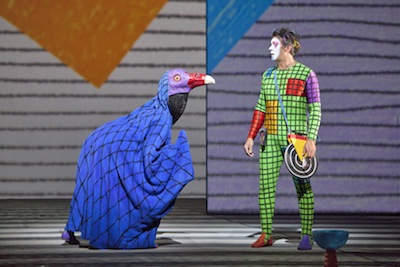
The magic of animation
Mozart’s “The Magic Flute”, full of mythic conventions and fairy tale creatures laced with more ponderous brotherhood mysteries, is an opera easily adaptable to fantastic productions. San Francisco Opera’s new production adds an unusual twist to the usual interpretations by enlisting artist Jun Kaneko for both set and costume designs.
Kaneko’s visual world is full of clear colors, hand-drawn grids, spots and geometric shapes, as if everything had been sketched with huge magic markers. What vivifies his approach and makes it engaging theatrically is that all of these “marks” are animated. Across sets that are essentially projection screens, these bright geometric forms promenade: a wayward red line courses diagonally across groups of red, yellow, purple and blue lines as they trace a vibrating grid. Between the Venetian blind-like stripes that lie across the screens in sorceror Sarastro’s realm, are bright fields of yellow and orange that diminish at the horizon into soft purples and blues. Papageno, the bird-catcher and wife-seeker, is dressed in green interrupted by black grids. Dots, irregular and hand-drawn, cover creatures and environment alike.
To achieve these effects the lighting design uses four projectors behind the sets and four in front.
Kaneko comments that the opera demands such a profusion of shapes formed and reformed into the subtly flickering movement of animation. As he points out there are some 28 scene changes in what is an unflaggingly vivacious piece of musical theater.
Then, of course, there is the restless story itself with its ambiguous and ambivalent characters, each set on his or her own contradictory quest. Papageno was sung by the adorable Nathan Gunn, matched by Nadine Sierra’s Papagena and a clutch of tiny Papagenos and Papagenas in egg-shaped costumes. Alek Shrader was a handsome and well-toned Tamino, in search of love and kingdom. Heidi Strober sang a rather dignified but charming Pamina.
Of the less innocent and less heroic sorts: Sarastro was sung, deeply, by bass Kristinn Sigmundsson. And Greg Fedderly made a superlative Monostratos, lecherous and conniving in his pursuit of the chaste Pamina’s body.
But at the top of my list for drop-dead gorgeous singers was the Russian coloratura with a name straight out of the opera, Albina Shagimuratova, who sang the Queen of the Night. And sang is the operative word. Although each note was punctuated clearly all the way up to the high F, her sound was consistently warm and beautiful. So beautiful that it was hard to think of the murderous Queen of the Night as anything but magnetically lovely. That was OK with me, and the audience seemed to agree. This year’s summer operas have a corner on truly fine high sopranos.
The opera was sung in English with lyrics by David Gockley and conductor Rory Macdonald, who did a wonderfully exuberant performance with the orchestra. The translation was very topical and ironic, pointing out some of the opera’s silliness, such as the “Chinese-inspired dragon.” It could have used a lick from a poet’s silver tongue though; even so, it was fun.
—Jaime Robles
San Francisco Opera’s production of Wolfgang Amadeus Mozart’s “Magic Flute” continues through July 1. Sung in English with English supertitles.
War Memorial Opera House, 301 Van Ness Ave., San Francisco. www.sfopera.org. 415-864-3330.
Nadine Sierra, as Papagena in disguise, and Nathan Gunn as the bird-catcher, Papageno, in San Francisco ’s new production of Mozart’s “The Magic Flute”. Photo by Cory Weaver.
